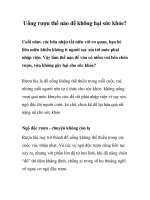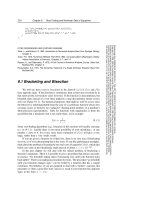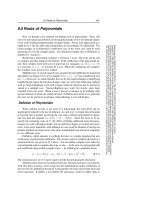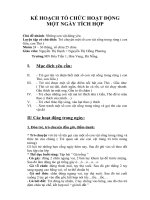Tài liệu TALKING IRISH THE ORAL HISTORY OF NOTRE DAME FOOTBALL docx
Bạn đang xem bản rút gọn của tài liệu. Xem và tải ngay bản đầy đủ của tài liệu tại đây (748.48 KB, 384 trang )
TALKING IRISH
THE ORAL HISTORY OF NOTRE DAME FOOTBALL
STEVE DELSOHN
For Mary Kay, Emma, Hannah and Grace
Contents
viiAUTHOR’S NOTE
1Part I: The Forties
31 Shadow of the Rock: 1940-1941
112 Leahy Takes Charge: 1942-1943
173 The War-Torn Years: 1944-1945
244 The Glory Boys: 1946
335 The Dynasty 1947-1949
39Part II: The Fifties
416 Power Struggle: 1950
477 Paying the Price: 1951-1952
538 The End of the Leahy Era: 1953
689 Two Stubborn Irishmen: 1954-1955
7610 Rock Bottom: 1956
8311 Notre Dame Under Fire: 1957-1958
9212 “A Hardheaded Croatian”: 1959
97Part III: The Sixties
9913 Once They Were Kings: 1960-1962
10714 Requiem for the Irish: 1963
11315 A New Messiah: 1964
12416 Shake Down the Thunder: 1965-1966
13417 Terry, Joe, and O.J.: 1967-1968
13918 Race
14719 Inside the American Whirlwind: 1969
155Part IV: The Seventies
15720 Kent State to Dallas: 1970
16521 Bowl Game Madness: 1971-1972
17422 Reaching for the Stars: 1973
18123 A Legend Departs: 1974
19124 The New Regime: 1975
20225 Turmoil and a Title: 1976-1977
21126 The Wheels Fall Off: 1978-1979
217Part V: The Eighties
21927 The Devine Era Ends: 1980
22828 Faust Fever: 1981
23729 Life With Gerry: 1982-1983
24830 Keystone Cops: 1984-1985
25931 The Little General: 1986
26832 Waking up the Echoes: 1987-1988
28033 Defending the Crown: 1989
289Part VI: The Nineties
29134 The Turbulence Begins: 1990-1991
30535 “Kind of a Lightning Rod”: 1992
31536 The Unforgettable Season: 1993
33237 The Boston College Hangover: 1994
34238 Holtz’s Cryptic Exit: 1995-1996
36139 New Morning in South Bend: 1997
Acknowledgments
About the Author
Other Books by Steve Delsohn
Cover
Copyright
About the Publisher
AUTHOR’S NOTE
I GREW UP PLAYING ORGANIZED FOOTBALL IN CHICAGO. I started
in sixth grade and quit when I finished high school. I loved the
game so fiercely, I cried harder than I expected when I left it be-
hind.
And so to be quite frank, it wasn’t Notre Dame that first drew
me to this book. It was my desire to revisit football. Then, once I
decided to write about one team, I made my mind up quickly.
Notre Dame is the very soul of football.
To bring this story to life, I have interviewed 144 players, 13
coaches, and seven administrators. This pool of Notre Damers
spanned six decades—from the 1940s to the 1990s—and included
62 All-Americans, 32 consensus All-Americans, 47 team captains,
five Heisman Trophy winners and five head coaches.
In 1996, I was privileged to attend the 50th reunion of Frank
Leahy’s 1946 national championship team, and the 30th reunion
of Ara Parseghian’s 1966 national champions. These weren’t only
two of Notre Dame’s best teams ever, but two of the greatest in
college football history.
One moonlit night in Palm Springs, I sat on a porch and drank
beer with Johnny Lujack. I talked with Parseghian in South Bend,
Indiana, where the view from his office window took in the
sparkling Golden Dome. About 18 hours after I interviewed Lou
Holtz, my wife gave birth to our daughter Grace. Holtz surprised
me with a phone call later that evening. He wanted to know how
mother and baby were doing.
I started researching this book two years ago. But as blasphem-
ous as it sounds, I had never before set foot on the campus of
Notre Dame. Now I know the scuttlebutt is true. Once you arrive
in the land of gold and blue, leprechauns and Touchdown Jesus,
you will be seduced. No other sports team, college or pro, has
such a rich blend of tradition and mystique.
In 1842, on a wooded plain in northern Indiana, the University
of Notre Dame du lac (Our Lady of the Lake) was founded by a
young French priest named Edward Frederick Sorin. The ambi-
tious Holy Cross brother wrote two years later: “When this school,
Our Lady’s school, grows a bit more, I shall raise her aloft so that
without asking, all men will know why we have succeeded here.
To that lovely Lady, raised high on a dome, a Golden Dome, men
may look and find the answer.”
It was 1882 when the Golden Dome first cast its glint across
the heartland. The university took up football in 1887. The first
team went 0-1, losing 8-0 to a visiting Michigan squad that agreed
to teach Notre Dame the country’s rugged new game.
In 1909, Notre Dame was still referred to as “the Catholics” by
sportswriters when Rev. Michael J. Shea wrote the music and
words to the Notre Dame Victory March. Nearly 90 years later,
its chorus can still brings tears to grown men’s eyes:
viii / TALKING IRISH
Cheer, cheer for old Notre Dame,
Wake up the echoes cheering her name,
Send a volley cheer on high,
Shake down the thunder from the sky,
What though the odds be great or small,
Old Notre Dame will win over all,
While her loyal sons are marching,
Onward to Victory.
By 1918, when Knute Rockne became head coach, the program
already had a winning tradition. Jesse Harper, Rockne’s prede-
cessor, had gone 34-5-1 over five seasons. But while few non-
Notre Damers remember Harper, Rockne is still the most famous
coach who ever lived.
A balding, broken-nosed genius, Rockne did more than win a
school-record 105 games. He transformed a small and obscure
Catholic university into an American institution.
In 1924, the year Notre Dame won its first national champion-
ship, Rockne’s backfield consisted of quarterback Harry
Stuhldreher, left halfback Jim Crowley, right halfback Don Miller
and fullback Elmer Layden. Though they averaged 158 pounds
per man, they grew immortal when Grantland Rice of the New
York Herald-Tribune sat down to write his story on the Notre
Dame-Army game in New York City.
“Outlined against a blue-gray October sky the Four Horsemen
rode again,” Rice wrote in the most unforgettable newspaper lead
of all time.
“In dramatic lore they are known as famine, pestilence, destruc-
tion and death. These are only aliases. Their real names are
Stuhldreher, Miller, Crowley and Layden. They formed the crest
of the South Bend cyclone before
THE ORAL HISTORY OF NOTRE DAME FOOTBALL / ix
which another fighting Army team was swept over the precipice
at the Polo Grounds this afternoon…”
Notre Dame had only won this game 13-7, but there was no
turning back. The Irish had become the stuff of myth.
Rockne’s single most fabled player was George Gipp. An extra-
ordinary halfback and a prodigious gambler and drinker, he was
named Notre Dame’s first All-American in 1920. Gipp died two
weeks later, at age 25, from a strep throat infection.
According to Rockne, Gipp made this stirring request from his
deathbed: “I’ve got to go, Rock. It’s all right. I’m not afraid.
Sometime, Rock, when the team is up against it, when things are
wrong and the breaks are beating the boys—tell them to go in
there with all they’ve got and win just one for the Gipper. I don’t
know where I’ll be then, Rock. But I’ll know about it, and I’ll be
happy.”
No one has ascertained if Gipp actually said these words. But
in 1928, Rockne made his storied “Win one for the Gipper” speech
before his outmanned Irish played unbeaten Army at Yankee
Stadium. Notre Dame’s soaring emotions ignited a 12-6 upset.
In 1931, millions of people grieved when they read the sky-
scraping headlines: KNUTE ROCKNE DIES IN PLANE CRASH. Notre
Dame spent its next ten years trying vainly to maintain its mam-
moth tradition. Then, in 1941, a brooding, eccentric Frank Leahy
took over as coach.
Leahy made Notre Dame a powerhouse again, and it is Leahy’s
first decade that kicks off Talking Irish. Why did I begin in 1940?
Talking Irish is an oral history, based on first-person accounts of
Notre Dame football heroes. And if you go all the way back to
1930, a number of those heroes are deceased.
In 1998, Notre Dame still has college football’s most
x / TALKING IRISH
hallowed legacy. After 110 seasons, the Fighting Irish have had
only nine losing records. Their 11 national championships, seven
Heisman Trophy winners, 77 consensus All-Americans and .757
winning percentage are all collegiate bests.
But the heritage goes much deeper. Numbers can’t capture the
spirit and the grit. Here is the story of Notre Dame football—told
by the men who lived it.
THE ORAL HISTORY OF NOTRE DAME FOOTBALL / xi
PART I
THE FORTIES
1
SHADOW OF THE ROCK
1940-1941
ON DECEMBER 7, 1940, DURING THE SEASON FINALE AT SOUTHERN
California, Notre Dame coach Elmer Layden charged onto the
field to protest what he felt was a rotten call. But Layden didn’t
stop there. After blistering the refs, he screamed at USC coach
Howard Jones.
A normally genial man, Layden had finally submitted to the
abnormal pressure of coaching Notre Dame football. This pressure
had increased for nine straight years—ever since March 31, 1931,
the stunning day Knute Rockne died in an airplane crash.
In the hard economic times of the 1920s, Rockne had brought
the school glamour and fame. He envisioned a Notre Dame Sta-
dium, then twisted enough arms to see it get built in 1930. Rockne
scheduled road games in New York City, Chicago, Los Angeles,
Baltimore, and Philadelphia, which in turn created the so-called
subway alumni. These were the millions of fans who never atten-
ded the university, but had passionate feelings for its football
team. During the 1920s, many of these fans were poor, Catholic,
and Irish. As they battled prejudice and struggled to join the
country’s middle class, they were inspired by Notre Dame’s
football success.
Then there were the remarkable statistics. Rockne’s teams lost
only 12 games in 13 years, posted five unbeaten seasons and won
three national titles. His lifetime winning percentage of .881 (105-
12-5) is still the highest in both college and pro football.
After Rockne’s shocking death at age 43—his small commercial
plane went into a lethal spin over Bazaar, Kansas—Heartley
(Hunk) Anderson replaced him. Anderson had starred at guard
under Rockne and still ranks among Notre Dame’s all-time hard
guys. In one game against Army, after George Gipp got kneed
by a Cadet, Anderson dropped the Cadet with one good shot to
the face.
Never the smooth politician Rockne had been, Anderson swore
like a trooper and lacked head coaching skills. His three-year-
mark of 16-9-2, including 3-5-1 his final season, got Anderson
fired on December 9, 1933.
Next came the ex-Four Horseman, Elmer Layden. As Irish head
coach from 1934-1940, Layden won nearly eight of every ten
games. At most other schools, this would have enhanced his le-
gend. But not at a Notre Dame still mourning Rockne, whose
three national titles had set a towering standard.
Layden didn’t win any championships. So in February 1941,
two months after his outburst at USC, he resigned before his im-
minent dismissal. Then it was Frank Leahy’s turn to grapple with
Rockne’s ghost.
Leahy grew up, aptly, in Winner, South Dakota. After playing
tackle on Rockne’s last three Notre Dame teams, he returned to
South Bend fresh from an 11-0 season at
4 / TALKING IRISH
Boston College. Leahy, at age 33, had only been a head coach for
two seasons. Yet he was college football’s hottest name.
Leahy was also a slew of contradictions. He dressed expensively
in double-breasted dark suits, wide-brim hats and bow ties. But
Leahy worked such late hours, he often slept on campus and
wore the same rumpled clothes for days at a time. Leahy always
displayed a certain blood-lust, both in his famously violent
practice sessions and earlier as a promising young boxer. Yet
when Leahy spoke, he sounded more platitudinous than pugilist-
ic.
“Approximately one month ago, I received the greatest surprise
of my entire life,” Leahy told the Notre Dame student body in
his first speech to them in spring 1941. “For it was just about four
weeks ago that the authorities at the University of Notre Dame
saw fit to ask me to coach at my Alma Mater. My vocabulary
lacks the words to describe fittingly the monumental feeling of
joy which permeated my entire body and soul.”
The greatest paradox was Leahy’s transformation during games.
Fanatically organized and a master tactician, he was a brilliant
practice-field coach. But Leahy got so emotional on Saturdays,
he could be more of a sideshow than a leader. Times like these
for instance:
• Long snapper Jim Schrader botched a key extra point, and
Leahy grabbed him and screamed, “You’ll burn in hell for this!”
• An Irish player hit an opponent so hard he knocked himself
unconscious. Then, as the trainer ran up with smelling salts,
Leahy sniffed them himself.
• Notre Dame and USC were tied 14-14 late in the fourth quarter.
Thinking the Irish were winning,
THE ORAL HISTORY OF NOTRE DAME FOOTBALL / 5
Leahy instructed his offense to run out the clock. Notre Dame
wasted a key timeout in its confusion, the game ended 14-14,
and the tie cost the Irish the 1948 national championship.
Still, these incidents happened later in Leahy’s career, when
the strain of the job may have taken a mental toll. In 1941, accord-
ing to freshman quarterback George Dickson, it was Leahy’s ob-
session with winning that made him the perfect candidate for
Notre Dame.
GEORGE DICKSON: “Leahy and I got close over the years. Prob-
ably because I went into coaching myself. Well, Leahy told me
himself what happened when Notre Dame hired him.
“He met Father John Cavanaugh in Albany, New York.
Cavanaugh was the school’s vice president, and the Notre Dame
VP is always in charge of athletics. So Cavanaugh goes over to
this hotel. He signs into a room under an assumed name. Leahy
also checks in under an assumed name. Leahy, remember, was
still at Boston College at the time. This was his job interview.
“Now this is what the old man told me himself. He said he told
Cavanaugh, ‘Well, Father, Elmer Layden’s been doing a pretty
good job.’ Cavanaugh said, ‘Yes, Frank, you’re right. But we want
winning teams here. All winning, Frank.’
“So Leahy said, ‘Tell me, Father. Are you prepared to meet the
demands of national championship football?’ Cavanaugh said,
‘Yes, we are prepared. At all levels, Frank.’
“See, this was very different. Because after Rockne died, the
school had tightened the screws on Anderson and Layden. And
here they’re essentially giving Leahy
6 / TALKING IRISH
carte blanche. They’re telling him flat-out: ‘We want you to win
big-time.’”
Bob McBride was also a Leahy confidante. After playing guard
for Leahy’s first two teams, he was captured by German troops
at the Battle of Bulge. In 1949, back in South Bend, McBride be-
came Leahy’s most trusted assistant coach.
BOB MCBRIDE: “Leahy arrived in February of 1941. From then
until spring football officially opened, Leahy had us practicing
inside. We played on this big dirt floor inside the old field house.
“We had a trainer that year named Scrap Iron Young. Any time
a player got punctured or cut, Scrap ran over and gave him a
tetanus shot. Because whenever that dirt floor got hard like con-
crete, they had a farmer come in and plow it with his horses. That
put some softness back into the dirt, but there was a lot of horse
manure plowed in too. Therefore, the tetanus shots.”
During the early 1940s, the game was more primitive in other
ways. There were only four officials to watch for cheapshot artists.
The rules on clipping were sketchy and barely enforced, so
players often got wiped out from behind. Players also still wore
leather helmets—the kind they folded up and stuck in their back
pockets. Even as helmets converted from leather to plastic
(between 1941 and 1943), the plastic ones did not have built-in
face masks. Those needed to be specially attached, which meant
nobody bothered most of the time.
Notre Dame end Bob Dove, a two-time consensus All-American,
never wanted to wear a face mask anyway. Dove didn’t care if
this meant shedding blood. He was old school before the term
got coined.
THE ORAL HISTORY OF NOTRE DAME FOOTBALL / 7
BOB DOVE: “I just couldn’t get used to that damn thing. In fact,
when we played Navy in 1941, I didn’t have a mask and they
broke my nose. When I reached up to feel it, my nose was way
over here. Under my eye.
“I kept playing of course. We all did at Notre Dame. With
Leahy, you weren’t hurt unless a bone stuck out.”
BOB MCBRIDE: “Bob Dove was a hitter. He was exactly the kind
of player Leahy wanted. That’s why Leahy had so much live
contact at practice. He wanted the hitters, not the hittees.”
BOB DOVE: “Creighton Miller was one of our sophomore full-
backs. He made All-American as a senior. He was unstoppable
in the open field.
“But Creighton wasn’t on a scholarship. His family paid his
way. You know what that meant to Leahy, don’t you? He couldn’t
control Creighton Miller the way he controlled us.
“Leahy didn’t like that. He was more or less of a control freak.
So he and Creighton Miller weren’t on the best of terms. One time
we watched a game film and Creighton missed a block. Leahy
kept making us watch the play again. Finally he said, ‘Lads, can
you spot Creighton Miller on this block? He’s the one who owns
the fur-lined jock strap.’”
CREIGHTON MILLER: “I didn’t know much about Leahy before
he got here. But he had a reputation as a tough guy. Everyone
kept saying he was a boxer. That’s how he was set up.
“I don’t think the priests at Notre Dame understood Leahy. I
don’t think they knew how tough he was. When you came back
to Notre Dame after the summer, Leahy would look at your
hands. If they weren’t cov-
8 / TALKING IRISH
ered with calluses, Leahy figured you were a candy ass.”
BOB MCBRIDE: “We played Carnegie Tech in Pittsburgh that
season. A year or two before this, they had started deemphasizing
football. So most people were beating them pretty badly.
“We only won 16-0, but that wasn’t what made Leahy so irate.
We had two short yardage situations. Once we needed a yard to
score a touchdown. Once we needed a yard to get a first down.
Both times we got stopped by Carnegie Tech.
“We were supposed to stay in Pittsburgh that night and come
back to South Bend on Sunday by train. But Leahy got us together
after the ball game. He said they were changing the plans. He
said we didn’t deserve to stay overnight in Pittsburgh.
“So we went straight from the locker room to the railroad sta-
tion. Next morning around 4:30, we arrived at a train stop in In-
diana. They had busses waiting to take us to Notre Dame Stadium.
We went straight inside and put on our pads, then came out and
practiced at Cartier Field. We started around 6 A.M. and practiced
for three hours. For two hours, we did live hitting. This was on
Sunday morning after a game.”
Through exploits like this, Leahy molded the prototypical Notre
Dame player: a fiercely committed young Catholic who liked
banging heads. In 1941, Leahy’s inaugural season, the Irish went
8-0-1 and wound up ranked No. 3. It was their first undefeated
record since 1930, when Rockne’s final team was 10-0.
However, the glow from that year diminished quickly, when
on December 7, 1941, Japanese aircraft bombed the
THE ORAL HISTORY OF NOTRE DAME FOOTBALL / 9
U.S. Naval Base at Pearl Harbor, taking 2,403 American lives.
Since most people believed that it would happen soon, our
entrance into World War II wasn’t shocking. But our vulnerability
at Pearl Harbor was. “Our planes were destroyed on the ground,”
President Roosevelt said in angry disbelief. “On the ground.”
10 / TALKING IRISH
2
LEAHY TAKES CHARGE
1942-1943
IN 1942, WHEN LEAHY DUMPED THE HISTORIC ROCKNE SHIFT for
the rapidly emerging T formation, millions of Rockne disciples
called it sacrilege. But the Chicago Bears and Stanford were
scoring loads of points with the exciting new offense and Leahy
felt the T was Notre Dame’s future.
In the ground-based Rockne Shift, the offense had largely relied
on the fullback or two halfbacks. Even when Notre Dame passed,
it was frequently one of those running backs doing the throwing.
But in the more pass-oriented T formation, the quarterback ran
the show. He stood directly behind the center (rather than several
yards back as in the Rockne Shift). From there he could spin, fake
hand-offs, and throw downfield.
All of which suited the skills of Angelo Bertelli. In 1941, as a
tall skinny halfback in the Rockne Shift, Bertelli couldn’t run over
a speed bump. But with his powerful arm and clever faking, he
led the Irish in passing.









